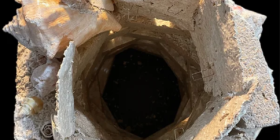Belonging to Soil
Amy M. Youngs creates eco art, interactive sculptures, and digital media works that explore interdependencies between technology, plants and animals. Her practice-based research involves entanglements with the non-human, constructing ecosystems, and seeing through the eyes of machines. She has created installations that amplify the sounds of living worms, indoor ecosystems powered by a rocking chair, an interactive museum for live insects, and an augmented reality tour of real nature. ‘Belonging to Soil’ is an art installation and virtual reality experience based on a critical ecological reality.
Belonging to Soil, 2023
Amy Youngs (Artist), Shadrick Addy (Designer), Mayen McClain (3D Environment Artist), Luke Stephens (3D Character Designer), JT Thrash (Lead Programmer), Andrew Sanchez (Programmer), Josh Rodenberg (Musician), William Yuan (3D Artist) and Megan Wright (Designer).

Belonging to Soil installation
How can we see under the surface – and get inside of soil?
Belonging to Soil is an art installation and virtual reality experience based on a critical ecological reality. The intricately interwoven ecosystem of soil contains billions of tiny creatures that our lives depend upon. How can we meet our friends who are doing the important work of absorbing waste and transforming it into healthy fertilizer that feeds the plants, which feed animals, like us? How can we see and experience these fascinating creatures who have complex, symbiotic relationships with each other?
This virtual reality experience Belonging to Soil is a simulation of the world of a springtail, a tiny creature living in soil ecosystems throughout the world. You inhabit the body of this arthropod avatar so you can travel as it does; riding on a flying ant to find new territory, leaping through the air to escape predators, swimming in a pond to catch and eat water bears, crawling underground to see the beauty there, exploring tunnels made by worms, eating sporulating soil bacteria, feeding plant roots, and dancing with friends.

Belonging to Soil interaction
The world inside the headset may look and feel like fantasy, but it is based on scientific knowledge. The research for this project involved reading scientific papers about springtails and their interactions with others in the soil ecosystem, as well as the observation of live springtails over two years, which I have cultivated in a variety of terrariums. The cartoonish avatar does not even come close to capturing the complexity of the actual springtails I observed. Their quick movements, their air-sensitive hairs, and acrobatics were not technically possible to include in a virtual reality system that assumes a human is controlling it. How would a human use their body to control six legs, plus two antennae, plus a furcula, which is the spring-loaded “tail” that activates their high-speed jumping? We don’t have enough limbs or even buttons on the virtual reality controllers to map to the actions of an actual springtail. It is humbling to attempt to simulate the operation of their bodies. It was also frustrating to working with a game engine that privileges two-legged, two-armed, upright-walking avatars. Our current avatar is a compromised in many ways: it walks upright, has only four legs, and its antennas are simply automated, not controllable. Nevertheless, we found ways to program the system so that users could experience jumping, eating, and “soil-making” (pooping) through particular body movements.

Belonging to Soil amplified Subterrariums

Belonging to Soil Subterrariums
Since the form of the springtail avatar did not live up to the complexity of the actual creature, I felt it important to bring them into the gallery so they could represent themselves. They are the size of a pinhead, which makes it challenging to notice at first; so a video microscope was used to capture and broadcast their lively movements on a large monitor for visitors to observe. Five small terrariums – dubbed “sub-terrariums” – were on display next to the monitor for further, close observation. Information about them was also shared.

Subterrarium

Springtails
About Springtails
- They are arthropods, who have a spring-loaded jumping organ that allows them to “hyperspace jump” – up and away from predators.
- They help build healthy soils by grazing on fungi, bacteria, and decaying matter, and by turning these into nutrients that plants can eat through their roots.
- The “earthy scent” that often occurs after it rains is due to a symbiotic relationship that one type bacteria (streptomyces) have formed with springtails. The bacteria creates the scent to attract springtails, who help the bacteria by spreading their spores (kind of like seeds) throughout the soil where new colonies can grow. The springtails are rewarded by a meal of bacteria, who are in the last stages of their lives when they are producing their spores.
- Fossilized springtails have been discovered in amber, clinging to the bodies of flying insects, causing scientists to believe that this is one method they used to travel and populate most types of terrestrial environments.
- They come in many types and colors, but they are so small and are often underground, so you might never see them.

Belonging to Soil – root sculpture
The Belonging to Soil installation includes a sculpture made of roots, which hangs above the head of whomever is wearing the virtual reality headset like a small canopy. It sets the stage for an underground experience, where the roots of plants, rather than their leaves, are a lively site of exchange between soil organisms. The complexity of these interactions are difficult to understand and impossible to simulate in a virtual reality experience. Even our attempts to simulate the three-dimensional structures of roots in virtual reality was humbling, let alone the problem of how we might simulate their ability to chemically communicate with springtails and the many other creatures that surround them.

Belonging to Soil Water Bear pond

Belonging to Soil Crystal Room

Belonging to Soil bacteria chamber

Belonging to Soil underground-2

Belonging to Soil roots
The team that created the virtual reality experience included artists (Amy Youngs, Mayen McClain, Luke Stephens, Josh Rodenberg), designers (Shadrick Addy, Will Yuan, Megan Wright), and computer scientists (J.T. Thrash, Andrew Sanchez). All collaborators are faculty, students, or alumni of the Ohio State University, except for Josh Rodenberg, faculty at Virginia Commonwealth University Arts Qatar, who created the custom music for the experience.
This project is supported by a grant from the Arts & Humanities at The Ohio State University.
………………………………….
Get the Full Experience
Read the rest of this article, and view all articles in full from just £10 for 3 months.



No comments yet.